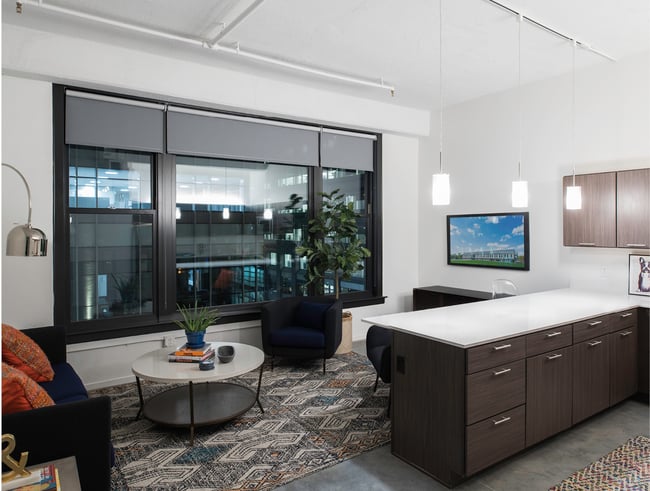Financial Incentives for Adaptive Reuse in Iowa

Adaptive reuse is the practice of repurposing an existing building for a new use. It’s an opportunity to save underutilized building stock, preserve a community’s historic character, and reduce the carbon emissions, waste, and resource consumption associated with demolition and new construction.
Due to its benefits, governments incentivize adaptive reuse through tax credits and deductions. Our experience with adaptive reuse includes projects like:
- Market One in Des Moines
- Wilkins Building
- Fort Des Moines
- Stanley Center for Peace and Security in Muscatine, IA
No matter the project, we help building owners explore funding opportunities and comply with the requirements. This article will discuss some of the financial incentives available for adaptive reuse projects in Iowa, including:
- State and federal historic tax credits
- Brownfield and grayfield tax credits
- Local TIF funding
- Federal tax deductions for EUI improvements
4 Financial Incentives for Adaptive Reuse
1. State and Federal Historic Tax Credit
State and federal historic tax credits encourage the redevelopment of historic buildings while retaining character-defining features and spaces. For adaptive reuse projects, historic tax credits are the most lucrative form of financing.
At the state level, Iowa building owners can receive a tax credit of up to 25% of the project’s qualified rehabilitation expenditures. Federal tax credits cover up to an additional 20%.
Qualified rehabilitation expenses are limited to those related to the design and construction of the building, such as:
- Architectural and engineering fees
- Site survey fees
- Legal expenses
- Construction costs
- Plumbing, electrical, heating, and cooling costs, including energy harvesting from renewable sources
Expenditures related to land acquisition, moving costs, street signage, appliances, and Furniture, Fixtures, and Equipment (FF&E) do not qualify.
While historic tax credits are effective, only select buildings qualify for the program. Eligible buildings must be “certified historic structures” or “contributing resources” in designated historic districts. For example, Market One, Fort Des Moines, and the Wilkins Building in Des Moines met these criteria.
An architect can help you determine your building’s eligibility or assist with the site selection process. If your building does not qualify initially, you may be able to make a case by applying with the State Historic Preservation Office.
Learn more by reading about the federal historic tax credit application process.

Wilkins Building in Des Moines qualified for historic tax credits.
2. Brownfield and Grayfield Tax Program
Adaptive reuse projects can also take advantage of brownfield and grayfield tax credits.
Brownfields are previously developed properties that may be contaminated by hazardous materials or substances. The EPA estimates there are over 450,000 brownfields in the US.
Grayfields, on the other hand, are vacant, blighted, or underutilized commercial, industrial, or public properties.
State and federal tax programs incentivize the redevelopment of brownfields and grayfields to increase tax bases, mitigate urban blight, and take development pressure off open, undeveloped land.
In Iowa, brownfield projects can receive a tax credit for up to 24% of qualified expenses. If the project meets green building requirements, the tax credit increases to 30%. Likewise, grayfield projects can receive a tax credit for up to 12% of qualified expenses and up to 15% for meeting green building requirements.
Green building requirements depend on the building type. Commercial buildings, for example, are considered sustainably designed if they receive a LEED Gold standard and if the building complies with the ASHRAE 90.1 Energy Standard. See the Sustainable Design Standards in the Iowa Administrative Code for a more detailed explanation.
Brownfield projects can deduct environmental cleanup costs at the federal level. All cleanup costs are fully tax-deductible in the year they incur.
3. Local TIF Funding
Along with state and federal tax programs, adaptive reuse projects may qualify for local funding opportunities.
Many communities throughout Iowa offer Tax Incremental Financing (TIF) to subsidize redevelopment, infrastructure, or other community improvement projects. TIF may either come in the form of up-front cash or tax rebates over a designated period.
TIF guidelines differ from city to city, but usually, funds are only available in economically vulnerable areas in need of redevelopment. These areas, known as TIF Districts, often contain underutilized existing building stock, making them ideal for adaptive reuse projects.
4. Federal Tax Deductions for EUI Improvements
If your building is not eligible for other forms of financing, you can still receive a tax deduction for performance improvements.
The 179D tax deduction incentivizes sustainable commercial building operations. Under the Inflation Reduction Act, commercial buildings with an Energy Use Intensity (EUI) 25% better than the current ASHRAE 90.1 baseline can deduct $2.50 per square foot provided the project meets prevailing wage requirements. The amount increases with further EUI improvements, capping out at $5.00 per square foot for a 50% improvement.
Existing buildings only need to show EUI improvements relative to their history. Projects can compare with the previous performance numbers rather than the ASHRAE 90.1 baseline.
High-performance systems can be a large upfront investment but offer a quick return on investment. Tax incentives make the initial investment more digestible and accessible.
Explore Other Funding Opportunities
Adaptive reuse offers the opportunity to reduce your carbon footprint and reinvigorate your community. Existing buildings can present challenges and additional costs, making funding opportunities important.
If you consider an adaptive reuse project in Iowa, you can find financial incentives at the state, local, and federal levels. Your architect can help you research options and comply with design and documentation requirements.
Along with these funding opportunities, your architect can also help you fund on-site renewable energy sources. Learn more by reading about financing options for solar power.